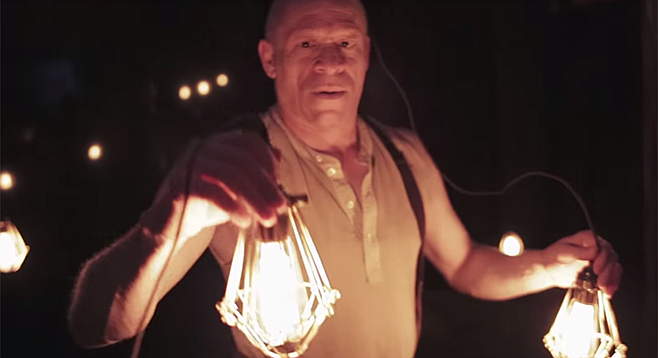 Facebook
Facebook
 X
X
 Instagram
Instagram
 TikTok
TikTok
 Youtube
Youtube
In her multimodal piece, choreographer Liz Lerman explores the resilience of humanity amidst the fog of war. Part modern dance, part dramatic performance, and part installation art, the interactive piece tells the stories of soldiers and healers struggling to cope with the physical and psychological wounds of war.
The audience begins the journey backstage, where small groups navigate a path adorned by a handful of Civil War tableaux. Soloists interpret death and healing with labored movements that feel more like the personification of raw pain than cultivated performance.

Walls peppered with quotes chronicle a complicated history of personal loss. Medical stretchers, dilapidated bed frames, and personal tokens of soldiers create a macabre museum-like setting. In a darkened corner, a shell of a man sits roped to his chair, tucked away from polite society – a common, post-war “solution” for medically traumatized soldiers.
A fictional Clara Barton affixes letters like leaves to an otherwise barren tree. Real-life Navy vet Paul Hurley chats with another man, unscripted, about the quirks that came with Hurley’s prosthetic leg.
Lerman’s juxtaposition of past and present, fictional narrative, and real personal memoir highlights themes of shared grief and communal healing that connect us over space and time.
Though the main performance is just over an hour, the content stretches decades. Individual performers fill thematically similar roles in each era, aiding the continuity of shared connection.
Most impressive is Lerman’s spatial storytelling. For the most part, the set is consistent. Cement pillars and a handful of benches and chairs adorn an otherwise stark stage. Metal hospital beds stripped of their mattresses hang in a cluster from the ceiling upstage—– a symbolic albatross of mortality that transcends era.

At times, healers of past and present mirror each other’s movements as they attend to the wounded, reminding the audience that while the techniques and elixirs have changed, the human need for comfort remains. In one era, the revelry of the Virginia reel allows a reprieve from the fog of war. In another, soldiers dance and lip-sync to Beyonce.
One of the most striking scenes spotlights Hurley. He recounts his own horrific tale while dancers swarm him in a chorus of movement that brings the turbulence of his violent accident to life. In the most stunning scene: Hurley and Keith A. Thompson lean on and lift each other up as each man literally carries the other’s burden.
The audience, too, is burdened by the stress of occasional terror: flashes of light mimic IED explosions that jolt us with the stress of shock. Video clips and infographics of brain scans project on the backdrop like informational birdshot, overwhelming the senses as they flash.
In these displays, Lerman’s mastery of storytelling is most salient. Our empathy is provoked. Raw, visceral reactions to sensory stimuli chip away at our guarded social veneers. We, too, comprehend the peace of healing.

In her multimodal piece, choreographer Liz Lerman explores the resilience of humanity amidst the fog of war. Part modern dance, part dramatic performance, and part installation art, the interactive piece tells the stories of soldiers and healers struggling to cope with the physical and psychological wounds of war.
The audience begins the journey backstage, where small groups navigate a path adorned by a handful of Civil War tableaux. Soloists interpret death and healing with labored movements that feel more like the personification of raw pain than cultivated performance.

Walls peppered with quotes chronicle a complicated history of personal loss. Medical stretchers, dilapidated bed frames, and personal tokens of soldiers create a macabre museum-like setting. In a darkened corner, a shell of a man sits roped to his chair, tucked away from polite society – a common, post-war “solution” for medically traumatized soldiers.
A fictional Clara Barton affixes letters like leaves to an otherwise barren tree. Real-life Navy vet Paul Hurley chats with another man, unscripted, about the quirks that came with Hurley’s prosthetic leg.
Lerman’s juxtaposition of past and present, fictional narrative, and real personal memoir highlights themes of shared grief and communal healing that connect us over space and time.
Though the main performance is just over an hour, the content stretches decades. Individual performers fill thematically similar roles in each era, aiding the continuity of shared connection.
Most impressive is Lerman’s spatial storytelling. For the most part, the set is consistent. Cement pillars and a handful of benches and chairs adorn an otherwise stark stage. Metal hospital beds stripped of their mattresses hang in a cluster from the ceiling upstage—– a symbolic albatross of mortality that transcends era.

At times, healers of past and present mirror each other’s movements as they attend to the wounded, reminding the audience that while the techniques and elixirs have changed, the human need for comfort remains. In one era, the revelry of the Virginia reel allows a reprieve from the fog of war. In another, soldiers dance and lip-sync to Beyonce.
One of the most striking scenes spotlights Hurley. He recounts his own horrific tale while dancers swarm him in a chorus of movement that brings the turbulence of his violent accident to life. In the most stunning scene: Hurley and Keith A. Thompson lean on and lift each other up as each man literally carries the other’s burden.
The audience, too, is burdened by the stress of occasional terror: flashes of light mimic IED explosions that jolt us with the stress of shock. Video clips and infographics of brain scans project on the backdrop like informational birdshot, overwhelming the senses as they flash.
In these displays, Lerman’s mastery of storytelling is most salient. Our empathy is provoked. Raw, visceral reactions to sensory stimuli chip away at our guarded social veneers. We, too, comprehend the peace of healing.
Comments